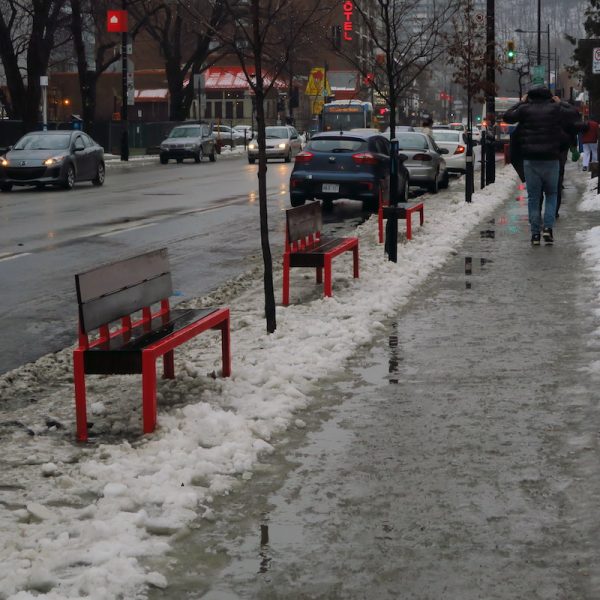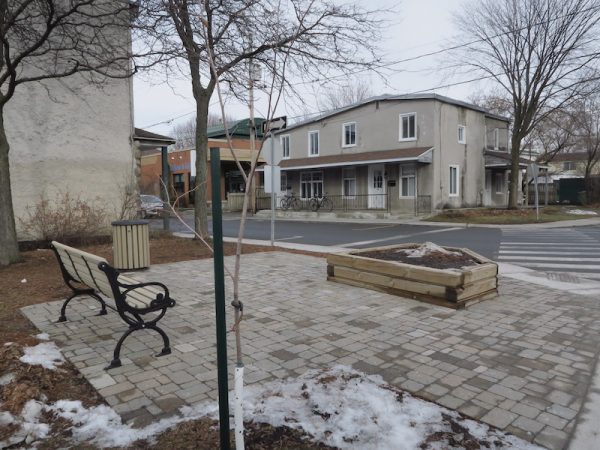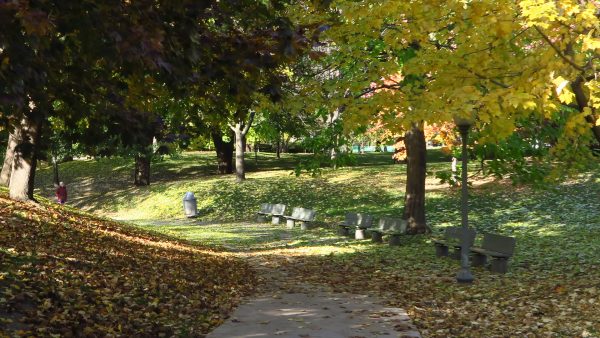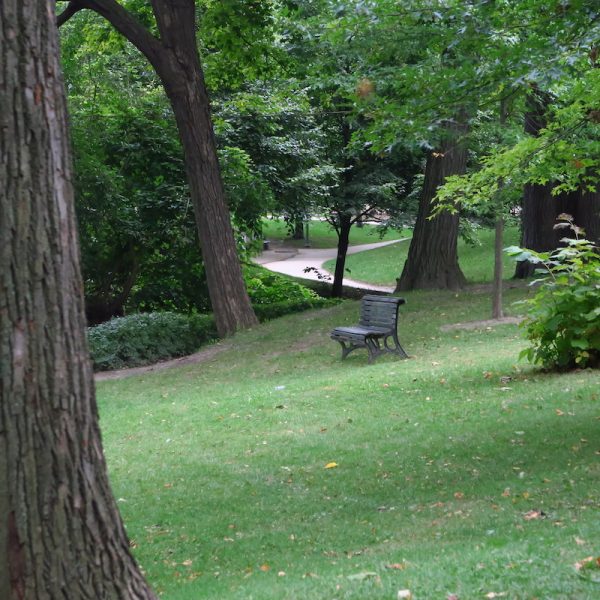Context
Perched on a grassy slope up from the sidewalk, located against a basement wall with no visible means of access, the feature image looks like a bench but for the questions tied to its use: who, why and how … unanswerable to one ignorant of its history and of whether it is on private or public land. The answers to these questions would delineate the nature of the bench as a “what”… as a historical and cultural “environmental figure.”
The bench as environmental figure
In his introduction to BENCHMARKING IN GERMANY, by the photographer Dirk Reinartz, the American novelist Thomas Quinn used a quote from Samuel Beckett stating, about a certain bench:
“And yet her image remains bound, for me, to that of the bench, not the bench by day, not yet the bench by evening, but the bench at evening, in such sort that to speak of the bench, as it appeared to me at evening, is to speak of her, for me.”
Beckett’s bench-as-experienced is an immanent environmental figure of who had used the bench, how and why; i.e. of its “what” as part of a historical and cultural environment.
The sidewalk bench as environmental figure

The sidewalk bench, facing the buildings with its back to the street, is a relative new development in my city where sidewalk benches are usually connected to bus stations i.e. placed so as to allow the sitter to look out to the street to see the oncoming bus.
Independent of this function, the sidewalk bench in that new location implies another type of user and use i.e. another “what” which is most probably “made of” people waiting for someone to exit one of the buildings, or people themselves having coming out of the buildings loaded with merchandise and needing to rest before starting their walk, or people waiting for the proper time, or expected company, to enter the buildings … etc.
These benches are now part of the street as a formally distinct (smaller, strait jacketed within a rigidly square red steel structure, for two sitters only) environmental figure associated with those who sit on them; a figure of a “what” best encapsulated in the title of Laurie Olin’s latest opus on park bench and seat design “BE SEATED” … somewhere between an imperative and a soliciting declination of the verb “to sit”, as any culturally meaningful activity, and setting, are.
The town street-corner bench as environmental figure

That street corner of a small town at the western tip of the island of Montreal fronts a small public parking lot and has been, dubiously so, dubbed a Park.
It will take a good twenty years of more before its two trees grow to provide shade for the bench, which meanwhile remains the most convincing symbolic feature of what is commonly understood to be a Park.
The small town is practically a village, for long a tourist destination for harried city dwellers, with very narrow sidewalks to accommodate the town version of the sidewalk bench discussed earlier.
The small town has a waterfront with its bench lined promenade heavily used in summer by boat gawkers and outdoor watering holes in the shade of trees … that waterfront may be construed as its only bona fide Park.
So what is the “what” of that bench beyond its symbolic presence and its traditional heavy curved black wrought iron structure and wood slats seat and back?
Two items tied to its location may provide an answer. The first is its location halfway between the very large public parking and the waterfront smaller ones, providing a moment of rest from carrying picnic items etc. The second is its location near the only supermarket located in the heart of the town providing an influx of local pedestrian traffic for tourists to watch while seated in the Park.
Separately these two items are not sufficient to define a what for that street corner park bench but put together they constitute the only opportunity for tourists and villagers to cross and see each other … the real “what” of that lonely bench as an environmental figure.
The city park bench as environmental figure – 1

Three pairs of benches assorted with an outdoor lighting post at one end and a garbage can at the other … all strung along a pathway in the main park, and extensive island of green, of the Anglophone enclave of Westmount.
The oversized concrete pile supports and steel substructure to hold the six straight wood planks that make each bench seem to be made to resist winter and the damage of snow removal equipment rather than receive shape of human bodies.
They are set in the most romantic part of that city park where pathways run between grassy knolls as so many pedestrian traffic channels on the edge of which the benches stand … empty for now.
The users are for these pedestrians, locals and others, to rest on if needed … their straight rigidity is in stark contrast to the soft rolling knolls and the vertical masses of the trees around them.
The bench linear layout seems to say to the user “rest a while and keep going”.
That is the essence of their environmental “what” … in sheer contrast with the next city park bench to be found elsewhere.
The city park bench as environmental figure – 2

Situated on the slope of one the largest grassy knolls of the same park is this one lonely bench of the classic Parisian “facture”: an Art Nouveau shaped steel structure delineating gently curved seat and back in one continuous roll, so to speak, of wood slats … all painted matching dark green to the surrounding tree foliage.
As such it may stand as the symbol of all city parks, almost sculptural in terms of its “what” environmental figure.
Not in a hidden but in a rather open location it still comes as a surprise to the wandering couple, seeking, consciously or not, some privacy for talking or a bit of physical intimacy.
The bare presence of the bench does not invite night time use under a light post, or a waste generating picnic activity requiring a nearby garbage can.
In terms of environmental figure, this bench appears to be the quintessential seating arrangement lovers may one day remember à la Samuel Beckett: “ … in such sort that to speak of the bench, as it appeared to me at evening, is to speak of her, for me.”
Discussion
At the end of his essay, in which he considers the various historical outcomes had Julius Caesar been sitting on a bench rather than on horseback as he conquers Gallia, or the mythical bench on a mountain top inviting the metaphysical musings of Goethe vs the tired plebe seeking respite, Thomas Quinn comes to the proposition that “ The bench in itself does not exist. It depends on who is sitting on it.”
A proposition I am inclined to accept as justified by the sample of benches presented and analyzed.
Bibliography
Olin, L. : BE SEATED, applied research + design publishing, N.Y., 2017
Reinartz, D.: BENCH MARKING IN GERMANY, Steidl, Göttingen, 1997
Credit Maurice Amiel for all photos
